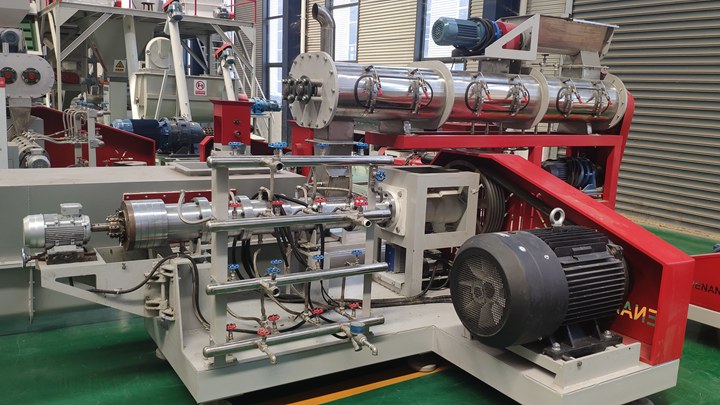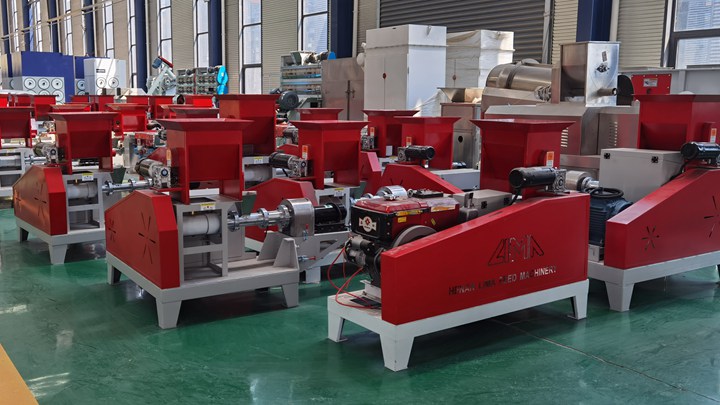Tilapia feed production line for commercial use in Ghana
-
.jpg)
The rise of tilapia farming in Ghana - Responsible Seafood
Nov 01, 2013 · Fish feed, however, continues to be a concern to farmers, as it constitutes 60 to 70 percent of the production costs for cage farmed tilapia. Nonetheless, the Ranaan fish feed mill in Ghana has reported it increased sales by four times in a single year. The cost of fish feeds ranges $1.00-2.50/kg, depending on source and brand. Tilapia fingerlings. Ghana has about seven hatcheries, with a few of them owned by the government.
Get Price -
.jpg)
Ghana: annual volume of tilapia production - Statista
Nov 29, 2021 · Get in touch with us now , Nov 29, 2021 Nearly 70 thousand metric tons of tilapia were produced in Ghana as of 2018. In the previous year, the production volume reached approximately 70.6 metric
Get Price -
.jpg)
Tilapia Fish Feed Pellets Formulation Fish Feed Pellet Machine
Sep 24, 2019 · Fish feed preparation on small-scale farms is labor-intensive, and the lack of amino acids in some components can affect feed quality. Commercial tilapia feed preparation, cooking, extrusion and pellet feed usually contain 32 to 40 percent protein. This could be fish meal or soy-based protein, the former more palatable to tilapia.
Get Price -
.jpg)
Tilapia Fish Feed Formulation; Tilapia Feed Ingredients
Apr 09, 2021 · Commercial tilapia feeds are formulated, cooked, extruded, and pelletized diets typically containing 32 – 40% protein. This can be a fish meal or soy-based protein, with the former being more palatable to the tilapia fish. Floating pellets are generally recommended, as they remain on the surface until consumed.
Get Price -
.jpg)
Tilapia farming in Ghana - Graphic Online
Jan 16, 2014 · Lake Harvest in Zimbabwe and Tropo Farms in Ghana are the biggest private commercial producers of Nile Tilapia in Africa, yet their reported production for 2012 was mere 7,000 tonnes and 5,000 tonnes respectively, very modest when compared to the global production figure of about 46.6 million tonnes.
Get Price -
.jpg)
FARMERS MANUAL ON SMALL-SCALE TILAPIA POND FARMING IN GHANA
Aquaculture has existed in Ghana since the 1950s, though the sector didn’t experience major growth until around 2000, when large-scale commercial production began. Today, it plays a key role in the nation’s prosperity, contributing to food security by augmenting domestic fish production and creating jobs.
Get Price -
Ghana Fish Feed Production Machine And Fish Farming Market
Jul 15, 2020 · In Ghana, fish feed is imported duty-free and operated by the private sector. All imported feeds are float-expanded feeds with particle sizes ranging from 0.3 mm to 6 mm. Powder/shredded fish feed is also imported. Beside commercially produced feeds, farm-made feeds and supplemental feeds (agriculture by-products) are being used locally, mainly
Get Price -
.jpg)
FARMERS MANUAL ON SMALL-SCALE TILAPIA CAGE FARMING IN GHANA
The Tilapia Seed Project is aimed at accelerating quality tilapia seed production and dissemination in Ghana. Project stakeholders produced this manual to provide accurate direction to small-scale fish farmers in Ghana. After reviewing its contents, we expect that it will prove instrumental in helping farmers improve production, and that it
Get Price -
.jpg)
Ghana looks to improve aquaculture feed production
Aug 17, 2016 · Because of its important role in the protein supply, a national policy on aquaculture was adopted three years ago with the objective to boost output from 13,000 metric tons to 40,000 metric tons by 2018. Among the challenges faced by Ghana’s fish farmers in achieving this goal is the shortage of locally produced fish meal and consequent need
Get Price -
Ghana Fish Farming and Fish Feed Production
Imported feed is appropriately 30% more expensive than locally produced. So importation is not a quick fix. On average the costs for Tilapia farming in Ghana consist of 70% of the feed cost. Therefore, the availability of high quality fish feeds is one of the major bottlenecks of aquaculture development in Ghana.
Get Price -

FAO: Feed formulation
Tilapia feeds accounted for about 8.1 percent of global aquafeed production in 2003. Commercial tilapia feeds are mainly dry sinking pellets and extruded floating pellets. Production estimates for farm-made tilapia feeds are not available as these are usually site specific and dependent on locally available feed ingredients.
Get Price -
.jpg)
Ghana's catfish and tilapia farmers vie for supremacy | The
Jun 24, 2022 · Ghana’s tilapia and catfish farmers are both optimistic about the growth of their respective sectors, leading to much good-natured talk about which will prevail in the long-term “war”. Ghana’s tilapia farmers are finally bouncing back after the twin challenges of ISKN virus and the Covid-19 pandemic. A recent visit to Lake Volta showed
Get Price -

FARMERS MANUAL ON TILAPIA HATCHERY OPERATION IN GHANA - aquaCase
The Tilapia Seed Project is aimed at accelerating quality Tilapia seed production and dissemination in Ghana. Project stakeholders produced this manual to provide accurate direction to small-scale fish farmers in Ghana. After reviewing its contents, we expect that it will prove instrumental in helping farmers improve production, and will serve
Get Price -
.jpg)
Evaluating commercial, intensive production of Nile tilapia
Sep 21, 2020 · Fish were fed commercial tilapia feeds (Vimifos) and followed established protocols for the farm. During the first month of the trial, a feed with 35 percent protein and 7 percent lipids was used before switching to a feed with 32 percent protein and 6 percent lipids, with soy inclusion levels of 43.4 and 33.4, respectively.
Get Price -

Tilapia Farming In Ghana: How To Get Started (2022)
Jan 04, 2022 · Tilapia Farming in Ghana You can also regard fish farming as an aquaculture business. You run the aquaculture business with fresh water fishes inhabiting shallow streams, ponds, rivers, and lakes. These Tilapia fishes are the second most popular fishes widely used in cooking Ghanaian meals.
Get Price